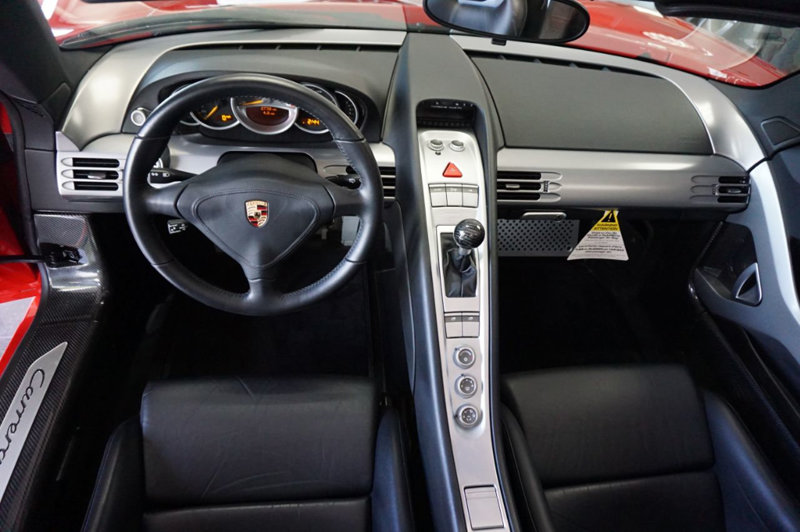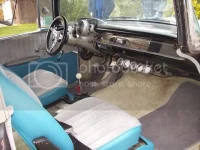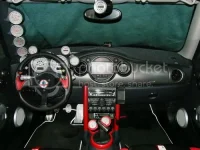That was probably the Triumph gearbox that BL made BMC use in the Marina and MGB, the BMC box was far better, but no syncro on first, not cool in the '70's. The Triumph box was so bad that a retro BMC box conversion was popular.My 79 1/2 MGB had the manual with electric over drive. So if you modified it to shift over gear in all instead of just 4th it made for cruising speeds a little nicer. Reverse in all MGB were a challenge to get to go into gear. The only solution was a tear down and polish the counter shaft gears or to replace them altogether with PG straight cut gears. That was in my other 305 V-8 MGB had that kool sounding gear drive whine.
You are using an out of date browser. It may not display this or other websites correctly.
You should upgrade or use an alternative browser.
You should upgrade or use an alternative browser.
Why isn't there a manual transmission standard shift pattern design?
- Thread starter CharlesInCharge
- Start date
Okay, thanks for the obvious explanations. Not to be argumentative, but there's a concept called muscle memory. And, what about what about 40 years ago? That's the purpose of this discussion. Long before any hint of phasing out manuals, when they were indeed very popular, why did the industry not standardize decades ago? Not talking about tomorrow here.
We get it, there's a lockout on the gears. But, repeatedly stated, mechanical designs can fail. A zillion recalls or poorly designed items in cars demonstrate this fact. Repeating that there's lockouts is something raised in my original post, and ten posts since then. Any theories on why a lack of a industry agreement on WHY not a standard, like we see a standard agreement on the location of the foot pedals, location of mirrors, etc?
No, not a lockout. the gears are moving and can't interlock, the reverse gear is not like the other gears that are constantly meshed. moving at any speed you can't mesh 'm you'd have no reverse gear left before you could get into reverse position while on the move. This setup is is typical for smaller cars, people will complain it's hard to select reverse even when stopped.
Here's a video of someone assembling a hyundai 5-speed with reverse right and down. I have it started just before he puts the reverse selector in. Notice how the straight cut gears are beveled, when the gears are moving (they move when the car moves) the bevel pushes the gears apart again. It is impossible to get into reverse on the move, maybe it works at 2-3 mph, but not more.
Others, those with a lock out, are constantly meshed and synchronised. Those you can select on the move but those have a lockout.
Mirrors are regulated by law, there's no industry agreement either. Pedals are also regulated, but can be moved for disabled people. ad a few cars in with the throttle on the left of the brake, and some with a hand throttle next to the gear shifter. Hand operated brake up there too, btw, the owner had legs only a foot long.
That was probably the Triumph gearbox that BL made BMC use in the Marina and MGB, the BMC box was far better, but no syncro on first, not cool in the '70's. The Triumph box was so bad that a retro BMC box conversion was popular.
The A-engined Spridgets did use a BMC gearbox-the same as used in the Minor-albeit the "rib cased" used in the 1275 Midget is considered a lot stronger and more durable than the earlier smooth-cased ones. I know the last Minor I drove had a smooth case hung off a 1275 and the owner/seller had both done the 1275 conversion himself and also rebuilt the gearbox(and I don't know why he didn't just transplant the rib case transmission that was sitting there in the Midget that donated the engine, and that I would have gotten with the car had I bought it). In any case, it was BAD. Not only was it sloppy but it also popped out of 3rd and 4th unless you sat there and held it.
With that said, that box is right and back, not left and back like the one used in the MGB.
The Midget 1500s do use the same Triumph box as the Marina, and it's up and right for reverse. When the BW35 died in my Marina, I actually talked to Skip("The Marina Man" in the US) about converting to a manual. He advised me not to do it both for the rarity of the Auto Marina and also for the fact that the BW35 is widely considered a stronger transmission than the Triumph box. His opinion, after having both sold Marinas new and worked in the service department, is that the little Spitfire transmission coupled to a B engine just wasn't up to the job of moving a 3000lb car around.
I actually asked him if anyone had ever put an MGB transmission in one. It would seem a logical swap as 4-sync non-OD MGB transmissions often fall into the category of "If you'll come to my garage/barn/shop I'll give you all you want", but aside from the 3-4 synchro sometimes cracking are pretty much a bulletproof transmission. The parts to bolt them to the B engine in a Marina are certainly not an issue either, and in fact more than one engine from a junked Marina found its way into an MGB-I think you just need the back plate and flywheel off an MGB. Skip said he hadn't known of any. Maybe one of these days when I'm in a better position to do that kind of work, I'll try it, as I feel like it would be a big improvement to the car(and cue all the jokes about how dropping a piano on one is the best improvement you can make to a Marina).
1 down 4 up is pretty standard in modern machines. The only alternative I've used is 1 down 5 up. 


Except for modified Race bikes and some companies like early 60-70's Bultaco and if I remember DKW but that was a long time ago. LOL1 down 4 up is pretty standard in modern machines. The only alternative I've used is 1 down 5 up.

According to the link, the model year for standardizing PRNDL was actually 1967. I understand some cars with automatics before that had R next to D (reverse next to drive). That seems like a recipe for disaster.Probably because it would have taken an act of Congress to do so. Look at the PRNDL standardization on automatics--before that, it was any mixture of positions, with or without park, and maybe even using buttons. Took a moment to find but apparently it was "fixed" in 1961. Link. Automakers were historically very against doing anything that impacted their bottom line--or change, really, not unless if they themselves instituted it. Over the last 50 years or whatever, just what would have been the impetuous for these automakers to get into a room and say "hey let's all have the same shift pattern?" what would it have profited them to work together on this?
Heh, I'm reminded of a story that my grandfather told me. At some point in time, he was asked to move someone's car. So he put it into reverse and... darn thing moved forward! Took him a while to figure out. VW Beatle, I'm guessing this had to be in the 1960's when this happened, and he was not the sort to have bought anything other than domestics with good ole 3 speeds at that time.
I believe the shift diagram we see on manual vehicles, usually on the knob, was also the result of a federal mandate. Older cars and trucks (1950s–back) often didn't have a shift diagram at all, just a bare knob.
CharlesInCharge
Thread starter
That's really good insightful information. Thanks for posting. It's fascinating that a manual would be made without any diagram. It's also curious why automatics (less complicated for the driver) would be mandated but manuals not. It would have taken 10 extra minutes.According to the link, the model year for standardizing PRNDL was actually 1967. I understand some cars with automatics before that had R next to D (reverse next to drive). That seems like a recipe for disaster.
I believe the shift diagram we see on manual vehicles, usually on the knob, was also the result of a federal mandate. Older cars and trucks (1950s–back) often didn't have a shift diagram at all, just a bare knob.
The Spridgets used the Morris Minor drive train...which was actually the Austin A30 driveline that the Minor got later in life. The Midget of course being a badged Austin Healy Sprite. I don't know what gearbox the small Marina used, but it wasn't the BMC one as it was syncro 1st. The gearbox in an 1800 Marina was always a problem, in the 1300 (1275) Marina the gearbox seemed pretty good. So maybe it couldn't handle the 1800 engine.The A-engined Spridgets did use a BMC gearbox-the same as used in the Minor-albeit the "rib cased" used in the 1275 Midget is considered a lot stronger and more durable than the earlier smooth-cased ones.
An auto Marina ? Not in New Zealand !
I learned a long time ago that a slight side load in the direction of the next gear (like going from 2nd to 3rd in the next gate on a 6-speed) helps prevent something like that. Takes some muscle memory training to do it without thinking. If shifting gears up/down in the same gate (1-2, 3-4, 5-6), no need and don't want any shifter side load.A good friend of mine had a Scout. He wound it out in 3rd and hit 2nd instead of 4th. Scattered a 304 IHC all over the street.
1 down 4 up is pretty standard in modern machines. The only alternative I've used is 1 down 5 up.

Some old english bikes are the reverse though
I have 4 VW's and two have revese push down and pull back like second gear and two have push down and go toward first gear. I just find out when I try to back up. Car I leared to drive a stick on was a 1958 Simca Aronde. It had 4 on the tree and as I recall first was down and toward me and reverse was neutral and push toward dash and push down. During driver license test drive, evaluator kept accusing me of starting in second gear. Most drivers have no idea of how to drive a stick shift. I like mine.
Not only have we no other members ever used a v-gate but I see no one mention the "ART" of speed shifting. 

JHZR2
Staff member
My personal favorite…

I’ve never had issues swapping MT vehicles, but I could see how it could happen, to op’s point.
On the above nv4500 I could see starting out in L vs 1, but it’s no worse for wear once in a while.
I’ve never had issues swapping MT vehicles, but I could see how it could happen, to op’s point.
On the above nv4500 I could see starting out in L vs 1, but it’s no worse for wear once in a while.
Here is my 02 MCS MINI and my 57, notice the shifters. The MINI is a PGT custom geared and "blue printed built transmission to handle 600+whp and the 57 is a Muncie 4 speed.
The MINI can be shifted without the clutch is necessary without grinding the gears, and the 57 anyone can shift without making a mistake going from like 1 to forth and it is impossible to go into reverse without being in neutral position and pulling the red lock out T-bar. You can also SPEED SHIFT as fast as you can humanly pull the handle never taking your foot off the throttle. On the 1320 it makes for consistent times and on the street you can smoke the tires in all 4 gears. LOL
Oh the 57 is powered by a transplanted built 482 BB with 2x 625 competition series Edlebrock/ Carter cloans . lol
The MINI can be shifted without the clutch is necessary without grinding the gears, and the 57 anyone can shift without making a mistake going from like 1 to forth and it is impossible to go into reverse without being in neutral position and pulling the red lock out T-bar. You can also SPEED SHIFT as fast as you can humanly pull the handle never taking your foot off the throttle. On the 1320 it makes for consistent times and on the street you can smoke the tires in all 4 gears. LOL
Oh the 57 is powered by a transplanted built 482 BB with 2x 625 competition series Edlebrock/ Carter cloans . lol
Attachments
self driving....however no ECU manual shift capacity lol
As some were talking about learning, I really had nobody to teach me. I started by taking test drives from sales guys who were willing to show me how to do it. I got different recommendations for how to handle it, but in the end I had to get a feel for it. I ended up buying one where the sales guy took me to a parking lot for a last lesson for an hour and I drove it home. I must have stalled about 5 times, but it wasn't too bad. I also took it only on surface streets all the way home.
As far as learning new shifters, that hadn't really been a problem until recently. I wanted to test drive a 2018 or 2019 BRZ and had a bunch of weirdness trying it. Many on the lot had dead batteries. We found one that didn't, but it was parked really tight, and the saleswoman taking us out didn't know how to drive it. I wasn't sure if I had it in reverse, inched forward, and braked. After a couple of tries I didn't want to hit the car in front and gave up. I later found out that Subaru now has a lock ring that has to be lifted to get it into reverse. I'd previously test driven a new WRX with a 6-speed and a similar setup, but it was dropped off on the street and I just had to drive it into the driveway, so I never had to play with reverse. They finally got me another one in the front with a dead battery, but they had to use a jump starter box. And I stalled it a half block away from the dealer. They finally got me the car that I previously couldn't get into reverse.
The weirdest I've seen (didn't get to drive it) was looking inside a Porsche Carrera GT. That was narrowest center section I've ever seen, and the shifter is mounted really high. The arm has to be extended way forward to reach the stick.

As far as learning new shifters, that hadn't really been a problem until recently. I wanted to test drive a 2018 or 2019 BRZ and had a bunch of weirdness trying it. Many on the lot had dead batteries. We found one that didn't, but it was parked really tight, and the saleswoman taking us out didn't know how to drive it. I wasn't sure if I had it in reverse, inched forward, and braked. After a couple of tries I didn't want to hit the car in front and gave up. I later found out that Subaru now has a lock ring that has to be lifted to get it into reverse. I'd previously test driven a new WRX with a 6-speed and a similar setup, but it was dropped off on the street and I just had to drive it into the driveway, so I never had to play with reverse. They finally got me another one in the front with a dead battery, but they had to use a jump starter box. And I stalled it a half block away from the dealer. They finally got me the car that I previously couldn't get into reverse.
The weirdest I've seen (didn't get to drive it) was looking inside a Porsche Carrera GT. That was narrowest center section I've ever seen, and the shifter is mounted really high. The arm has to be extended way forward to reach the stick.

WOW! Reading many of these responses is why I have always believed that getting a driver license should be more in line with getting a pilots license. 
Not only have we no other members ever used a v-gate but I see no one mention the "ART" of speed shifting.

So?
Similar threads
- Replies
- 77
- Views
- 3K
- Replies
- 32
- Views
- 2K
- Replies
- 15
- Views
- 740


